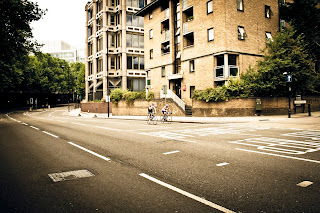@Caitiewrites, @potoft and I go on an adventure in Wonderland and we bump into Rory Kinnear. See Caitlin's account here.
Monopoly Money
Over a recent game of Uno, a friend commented on their competitive streak when playing Monopoly (triggered by me cheating against an 11 year old). Monopoly as a game doesn't really appeal to me as my competitive streak lasts all of 15 minutes, or until the bowl of game snacks runs out and it doesn't really help that there isn't a readily identifiable end point. However, it did remind me of some research I did out of curiousity a few weeks ago.
I had wondered whether or not the prices on the Monopoly board in anyway reflected the prices of properties in London in 1935 when the game was first published and whether the differences in value between properties was representative of real house prices at the time.
Clearly, without the benefit of particulars from real estate agents of the period it's difficult to know whether they were representative.
Step 1: What are properties worth nowadays
What I have done is investigate the average sale price of properties on Monopoly Streets in recent years. Unfortunately the British publishers of the game didn't give due regard to someone investigating these questions 77 years down the line. Some of the problems I have faced in undertaking this task have included the fact that a number of properties do not have residential properties on them (Trafalgar Square, Leicester Square etc), or are very short streets (Vine Street is all of 30 metres long) meaning there is low turnover of properties and thus available data. For others like The Angel, Islington, which aren't even streets, I've used Upper Street as a proxy (seeing as Pentonville Road is already included).
Of the 22 monopoly properties, I have managed to research indicative prices for 14 of them using Land Registry data. In addition I've also used estimates from Zoopla which predict values based on other local properties and historic sales figures. This is however somewhat of a data parlour game rather than rigorous research and analysis.
Monopoly inflation
So,using the original price per the cards, and the recent sale proceeds I calulated the effective rate of annual inflation for the properties is 10.2-12.0% based on the average value of sales and 11.1-14.0% based on Zoopla's estimates (assuming the Monopoly prices are realistic!).
Now, the question is, is whether or not this is a realistic level of house price inflation - if it's not, then the Monopoly prices are clearly not representative.
Measuring house price inflation is very difficult - there are all sorts of issues, such as the mix of property, the number of sales and the types of properties coming to market. I've looked for an index which goes back as far as possible.
Nationwide's index goes back to 1952, and estimates that the average house price in 1952 was £1,981, with the average for older houses calculated at £1,524 and 'new houses' as £2,107. From 1952 to 2013, the effective annual inflation rate was 7.58% for all properties and 7.98% for older properties, which is 2-6 percentage points less than our Monopoly inflation index, which means unless there was a large amount of inflation from 1935-1953, it looks like the prices in Monopoly are too low.
However, the Nationwide figures, are, national, and don't consider local variation. Halifax's index doesn't go as far back (only 1983) but does calculate regional inflation, with London inflation 17% higher than the UK as a whole. Applying this uplift to the Nationwide figures still however only lifts the inflation rate to 9.3%.
Playing around a bit more, if we use our inflation rates based on modern prices against Monopoly card prices to inflate the prices until 1952, and then uplift using Nationwide's index from 1952 to 2013, the modelled values are markedly lower than actuals. So all in all it seems that even in 1935 £200-300 for a property was actually a bargain.
But, what is interesting is the relative pricing of the squares in 1935 compared to the relative pricing in 2013. If you look at the chart below, you can see there is actually a reasonable correlation between the monopoly prices (x axis) and the actual prices (y axis). The two outliers are Bond Street (£320/£700k) and Fleet Street (£220/£392k), both of which I expect are affected by the small number of residential properties changing hands. So even if the prices weren't accurate in 1935, they appear to be relatively accurate for today's property market.
Schlep to Strasbourg
Our last excursion to the continent was inspired by seeing a segment on the TV programme Coast about the Beglian kusttram, whilst with similarly mediocre wanderlust, this trip was driven by filial duty to see my sister-in-law @pip_en_france, who has been living in Strasbourg.
Aside from the Accor Hotels booking process falling over when 'verified by visa' kicked in and two payments taken (and bookings made) but without any confirmation that the first payment or booking had been processed, the arrangements were simple and easy (on receiving my credit card bill and enquiring the hotel immediately refunded the second amount). A problematic lack of availability at our preferred hotel on one night resolved itself when we were offered a voucher for a free night's stay at a hotel just around the corner in exchange for some organic deodorant. No, seriously.
So all that was left to do was pack the bags and head to St Pancras for the silly o'clock train to Paris Gare du Nord. To get the holiday started I eased myself into a cabbage based diet, by wolfing down a sauerkraut and pastrami bagel. @potoft's priorities were focused on a pain au chocolat to build up her tolerance of butter and chocolate.
On the Eurostar I had booked two airline style seats to avoid any form of engagement with other people and to facilitate appropriate napping without worrying about drool, snoring or a gaping mouth (mine or others). The journey was rather uneventful, and I remain distinctly unexcited about the repeatedly offered opportunity of trying a selection of Waitrose produce 'honestly priced'.
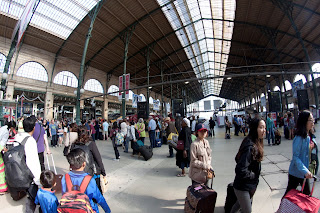 |
| Gare du Nord |
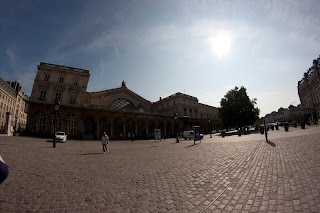 |
| Gare de l'Est |
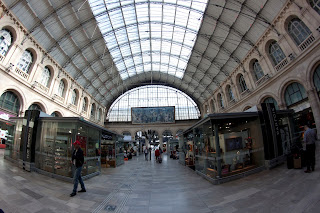 | |
|
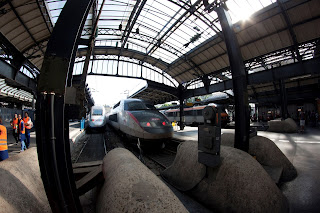 |
| Selection of French trains |
 |
| Eastern shopping concourse, Gare de l'Est |
Other than every flat surface outside being covered in graffiti, we knew we had left the UK when we watched a father give his 10 year old son some cash and sent him into the café. In he traipsed, walked up to the fridge unit, stood on his tiptoes and reached down a can of Carlsberg, got in the queue, handed over the money and walked off with his beer, no questions asked, clutching it like one our resident squirrels stealing from my bird-feeder. There is clearly no 'challenge 25' in France, more a case of if you can do your shoelaces what harm can a beer do?
As our platform was announced we headed off, grabbing some flowers for Pip and walking down the platform. Gare de L'est has a large number of platforms but achieves this by having very narrow platforms (think Clapham Common Underground station), made worse by clutter such as disused stairwells, well wishers and smokers puffing their last two packets of fags before boarding the train. Our train was made up of two units, one terminating at Strasbourg and one going to Stuttgart which confused matters as although there was a full run of carriages from 1 to 18 the numbering ran from 1 to 9 before switching halfway along to 18 to 10.
 |
| Empty TGV |
I was very taken by the TGV, especially as it was a double decker and we were on the top. It felt a lot more modern than previous trains I've been on between Bolougne-sur-Mer, Calais and Lille, which are similar to Eurostar but with a 1980s palette of grey and yellow. Having been sat on the train for 15 minutes, I was less than impressed at the announcement after its scheduled departure that 'personnel' were not on the train and we would not be leaving until they were found. 20 minutes later the Strasbourg express was on its way.
 |
| TGV Buffet car |
 |
| That's what the vicar said to the boy - a two and a half hour tutorial on how to use a smart phone. |
A recent trip to Birmingham was considered a stonking success as the return leg was pepped up by the disappearance of a man who abandoned his laptop and possessions leading his colleague to fear he had alighted by mistake at Coventry. I confronted the train manager, who denied that the man could be on the train and was definitely not locked in a toilet. On demanding that the train manager unlock a toilet which had been occupied for the duration of the trip, the gentleman emerged from the very cubicle. His story was that he had been 'ill' and had been unconscious - however to the outside observer it was clear that in fact I had thwarted a kidnapping plot.
Having never been to Strasbourg I had no real idea of what the terrain would be like. For long periods the landscape between Calais and Strasbourg is dull. Exacerbating this is the fact that the TGV is built for speed and is very straight and very flat. The moment there is the slightest undulation in the land the train disappears into a cutting, or even worse, a tunnel. On train journeys, there is nothing more enjoyable than staring out of a window on the inside of the bend watching the locomotive pulling the train, alas the very gentle bends on this TGV line does not give this opportunity. There is some beautiful scenery to be had on the TGV, including what looked like a ruined castle, but unfortunately, it requires you to be attentive and patient for long periods, and a glimpse of French scenery is a cruel mistress which will desert you without warning.
 |
| Flat territory |
 |
| Cutting |
On arriving at Strasbourg, we discovered that not only are French train platforms are quite low compared to the UK, but when you're in carriage 15 they are particularly low as the platform at Strasbourg is too short for the train.
 |
| Please mind the jump |
 |
| Peeling paint |
The platforms are elevated above the station concourse, meaning access to platforms is via tunnels rather than bridges, and combined with the design of the station building means the main concourse, shops and ticket hall are rather dark, and in addition one cant walk the length of the station building without exiting the original building (you can't get directly from buying a ticket to the main cluster of shops). The remedy to this is a striking modern addition: a large curved glass extension that runs the entire length of the original station building and facilitates access between the three tunnels under the platform and provides an interchange with the underground section of Lines A and D of the Strasbourg tram (line C is accessed at street level outside the station) but can't help but feel tacked on.
 |
| Glass extension on the front of the station |
A train to Stratford, a walk down The Highway and a non-existant bikeride
Working on the highway, laying down the blacktop
Working on the highway, all day long I don't stop
Working on the highway, blasting through the bedrock
Working on the highway, working on the highway
-The Boss
A photo-heavy word-light (ish) post for a change showing some of the things I got upto this weekend. Saturday saw us head off to Moka East at the ViewTube with my sister-in-law to admire the Olympic Stadium and have some breakfast. My two companions chose the full English, whilst I went for a broccoli and goats cheese frittata which was pretty tasty and made for a change from the standard brunch fayre available in most cafés. You'll see below some photos of Moka East's post-apocalyptic surroundings (though again I should emphasise it's actually a nice walk).
Having practised my insect photography during the week I had a potter about the garden at the ViewTube and the patches of wilderness planting. Even though the ViewTube is immediately next to the train lines coming out of Stratford, it's a really pleasant, secluded spot for a drink or a bite to eat if walking the Greenway.
On Sunday, it was another quiet day, though this time the peace and tranquillity came from the closure of The Highway. Normally for the marathon and the Triathalon, the road is closed to allow someone else to use it. And this was the case, but unfortunately, the users of the road were some cyclists going through at 7.30 and a few professional cyclists 5 hours later. I had needed to cross The Highway and had walked up to Glamis Road to use the subway assuming I wouldn't be able to cross, but on finding the road abandoned at 10 am I decided to be a bit of a radical and walked down the middle of the road in sections as I ticked off my E1/W to-do list, ultimately walking its length to St Katharine Docks. An unexpected pleasure was hearing the shrieking of a peregrine falcon as it carried a whole pigeon back to its nest and then began to devour it. An 'amusing' sight (given the relative size of the birds) and a spectacular one, especially for a day in the city.
Despite not advertising the ability to exit Wapping, I did spot one motorist successfully negotiate with a steward to let them cross from Vaughan Way to Dock Street, but another at Garnet Street was unsuccessful at being offered a way to exit Wapping. All the while for about 5 hours the road sat empty and unused, with stewards unoccupied bored rigid playing on their phones. I understand the need to let the mass of riders start first, as they take longer, but there must be a better solution than closing so much road capacity for so long and preventing access to locals.
Onwards we made our way, having a coffee at White Mulberries, but not before spotting a chalked graffiti tag that I have now seen at Wapping Station, Thomas More St and Brick Lane. Some research is in order. My final spot was the ongoing progress on the expansion of Pumblechooks.
As an aside and following on from my post on wildlife last week (and accounts of youths killing birds), when I was undertaking my tour of The Highway, I saw and spoke to a friend who gives up her evenings to assist youth workers. Together, they walk the streets at night speaking to teenagers who are out on the street. During Ramadan she does this nightly as more Muslim teenagers are allowed out whilst their parents are at prayers. Another friend with us was cautious about how effective this was, and what the dangers were (he once spoke to some teenagers sat on his garden wall and then discovered his car windows had all been smashed the next day). Having heard from my friend previously how she deals with a group of boys who hang around her bin room drinking (basically being polite, acknowledging them and treating them as a neighbour, including offering cake) I'm a great admirer of the technique. At the times that I'm about I don't really encounter ASB, so the opportunity to engage isn't there, but did make me question if more could be done. Whether or not the work going on across Tower Hamlets could be replicated in Wapping I don't know, but it has made me question whether I am doing enough to be part of a positive solution, rather than relying on others to move the problem onto someone else, and my current inaction doesn't sit well with me, but I need to find the courage as well as conviction to act.
Labels:
E1W,
LBTH,
local,
moka east,
pumblechooks,
Ride London,
RideLondon,
Road Closures,
stratford,
the highway,
viewtube,
Wapping,
wapping wildlife
Subscribe to:
Comments (Atom)













































